Stepping into the Romanian wedding scene is like entering a world where tradition and beauty dance hand in hand. The bride often dons a dress reflecting the rich tapestry of Romanian culture. These dresses are not just garments; they are storytellers, weaving together threads of wedding customs and history in the country. Picture intricate embroidery, vibrant colors, and symbols that echo the Romanian tradition. As I guide you through this journey, you’ll discover how each detail, from the groom‘s attire to the wedding reception, holds cultural significance. Join me as we explore the essence of these wedding dresses and the traditions that make these celebrations a unique tapestry of love and heritage.
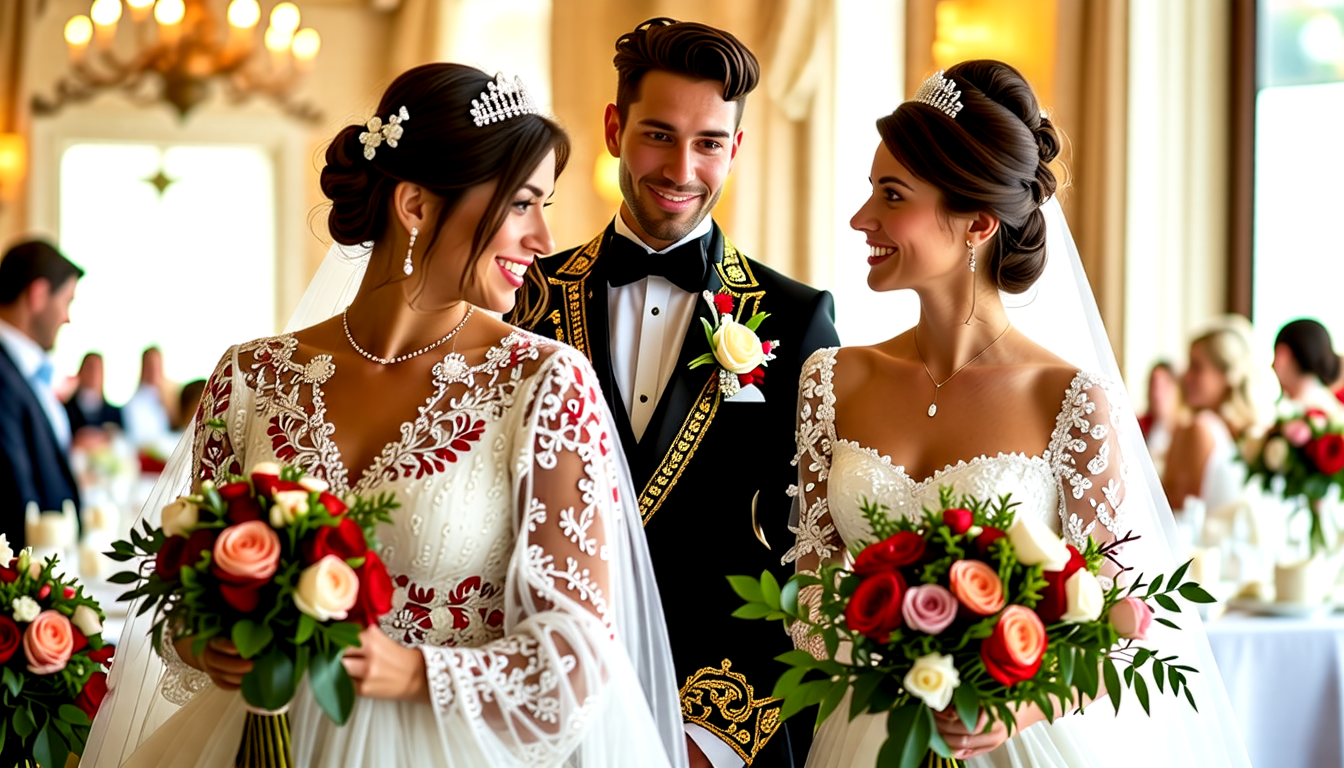
Weddings in Romania are steeped in tradition, with the bridal dress holding immense cultural significance. The bride’s attire is often a work of art, featuring intricate embroideries and vibrant colors that symbolize various aspects of Romanian life. Each stitch and pattern tells a story, reflecting the rich tapestry of Romanian culture.
The bride, beautifully adorned, becomes the living embodiment of Romanian customs. Her gown, often handmade, showcases Romanian wedding traditions passed down through generations. It’s not uncommon to see the groom and his family deeply involved in the selection and even the crafting of the dress, symbolizing unity and commitment.
During the wedding ceremony, the bride’s dress plays a central role. It’s not just a garment but a symbol of purity, fertility, and the blessings of Saint Mary, deeply revered in Romanian culture. As part of the ceremony, a traditional Romanian wedding blessing is often performed, invoking the saints and ancestors to protect the couple.
Following the ceremony, the wedding reception is a feast for the senses, featuring traditional Romanian dishes. If you’re curious about these culinary delights, I recently wrote about traditional food in Romania, which often graces the tables at these joyous events.
The dress, alongside the wedding cake and other elements, becomes a tapestry of memories, capturing the essence of a Romanian wedding. It’s a celebration of life, love, and cultural heritage.
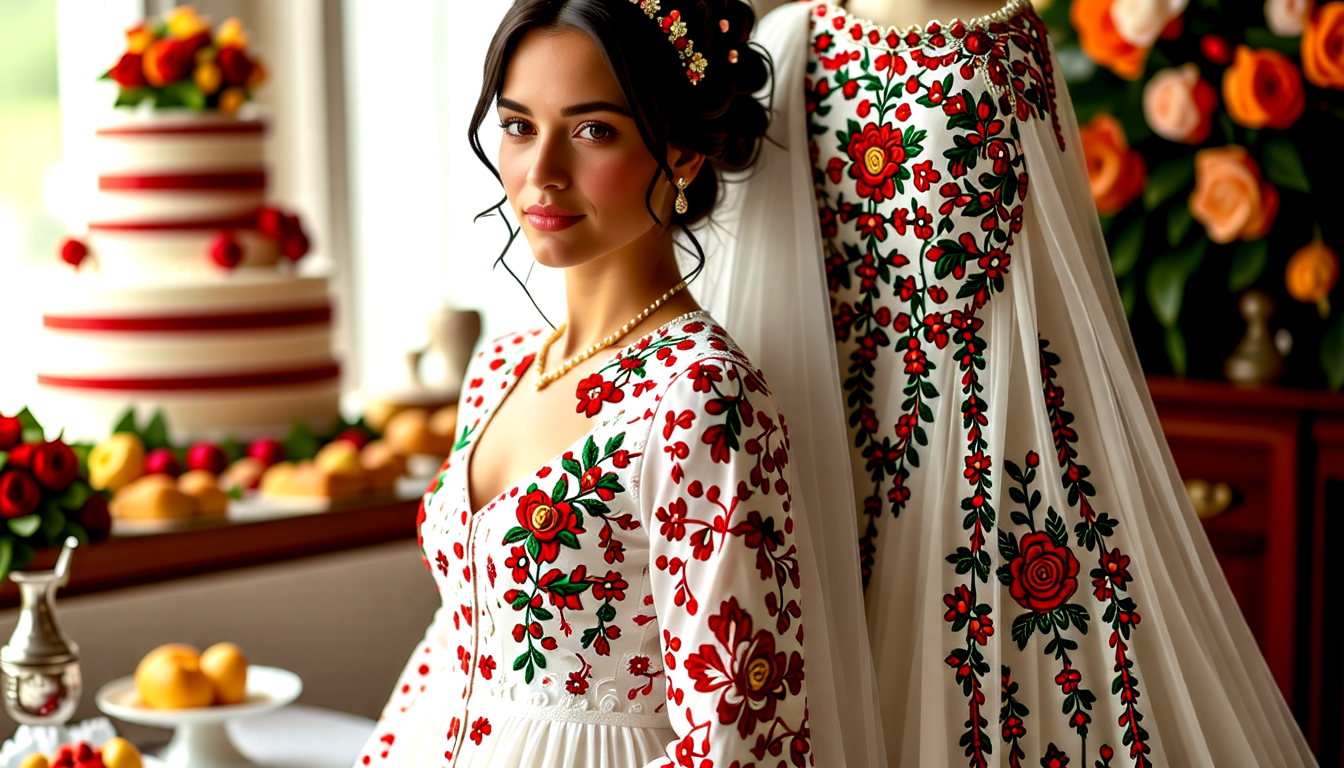
Traditional wedding dresses are a stunning reflection of Romanian culture and its deep-rooted customs and reflects the importance they give to the wedding party. Adorned in vibrant, hand-embroidered garments, the bride stands as a testament to the country’s artistic heritage. Each stitch tells a story, often passed down through generations, symbolizing familial love and continuity.
In many regions, the wedding dress is crafted over months, involving meticulous attention to detail. The bride’s attire typically includes bright colors and intricate patterns, inspired by nature and local folklore. A common feature is the marama, a delicate headscarf that adds an element of grace and modesty. The groom also wears traditional attire, often complementing the bride’s elaborate outfit with embroidered shirts and woolen vests.
Romanian wedding customs are not complete without the ceremonial blessings and rituals. These include the wedding cake and the heartfelt moments shared during the wedding reception. The celebration often extends into the wee hours, with dances and music resonating through the night.
In my exploration of life in Romania, I’ve noticed how deeply these traditions are ingrained in everyday life. You can feel the essence of these customs even in modern settings, bridging the past and present seamlessly. For instance, while visiting life in Romania, I observed how these practices are cherished and preserved by the younger generations, ensuring that the cultural tapestry remains vibrant and alive.
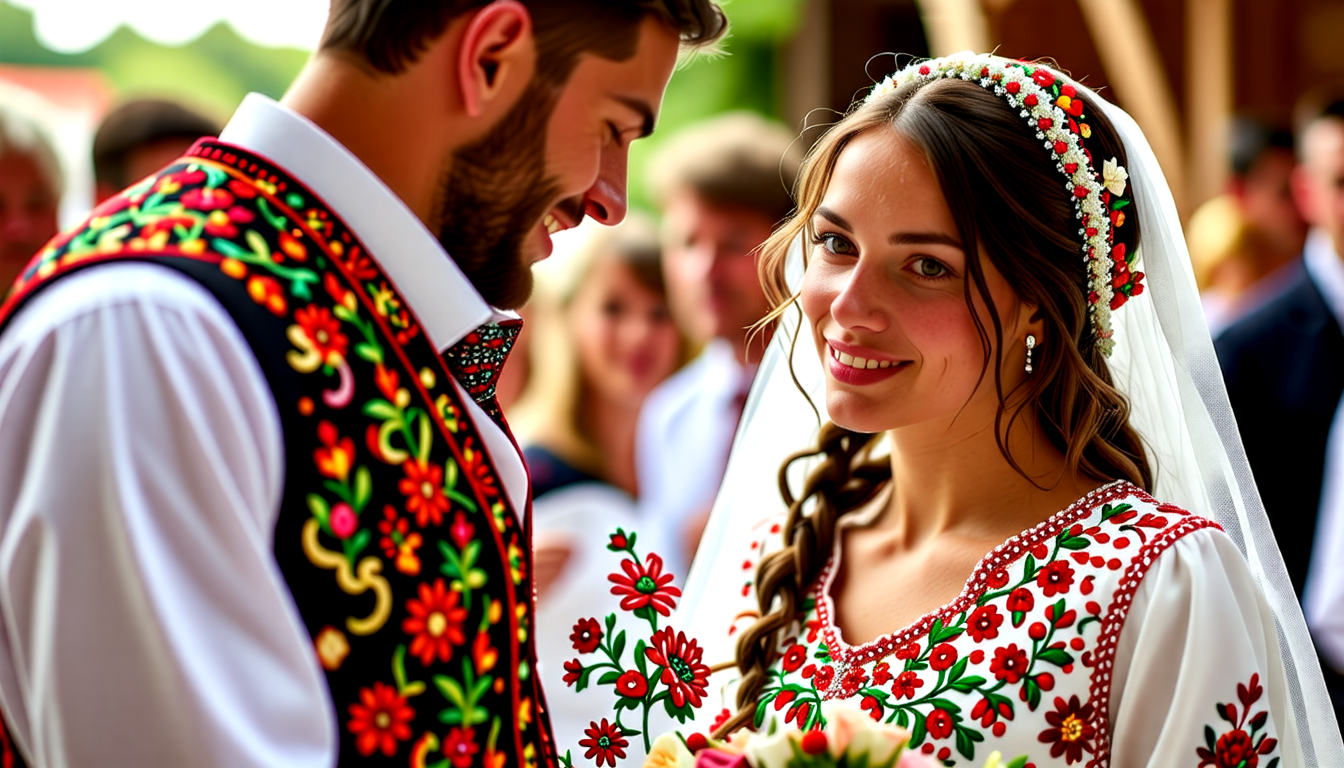
A Romanian wedding dress is a tapestry of tradition and artistry. Each garment is a masterpiece, reflecting the rich culture of Romania. The dress often features intricate embroidery, with designs passed down through generations. These patterns tell stories, making each piece a living canvas of history.
The bride typically wears a white dress, symbolizing purity and new beginnings. However, unlike Western styles, Romanian bridal attire might also include vibrant colors and elaborate details. The groom often sports a traditional outfit, complementing his bride’s ensemble. Together, they create a harmonious visual symphony.
At the wedding reception, the attire becomes a focal point of admiration and celebration. Guests marvel at the craftsmanship, as the couple dances the night away. The dress not only highlights the beauty of the bride but also underscores the importance of Romanian culture in the celebration.
A key element of the dress is the wedding blessing embroidery, believed to bring good fortune. Parents play a crucial role in this tradition, often involved in the dress’s creation or selection. The bride’s attire is more than just clothing; it’s a symbol of family and community, binding past and present.
These dresses are often kept as heirlooms, passed down to future generations. They serve as a reminder of the enduring nature of Romanian culture and the deep-rooted traditions that continue to shape these joyous celebrations.
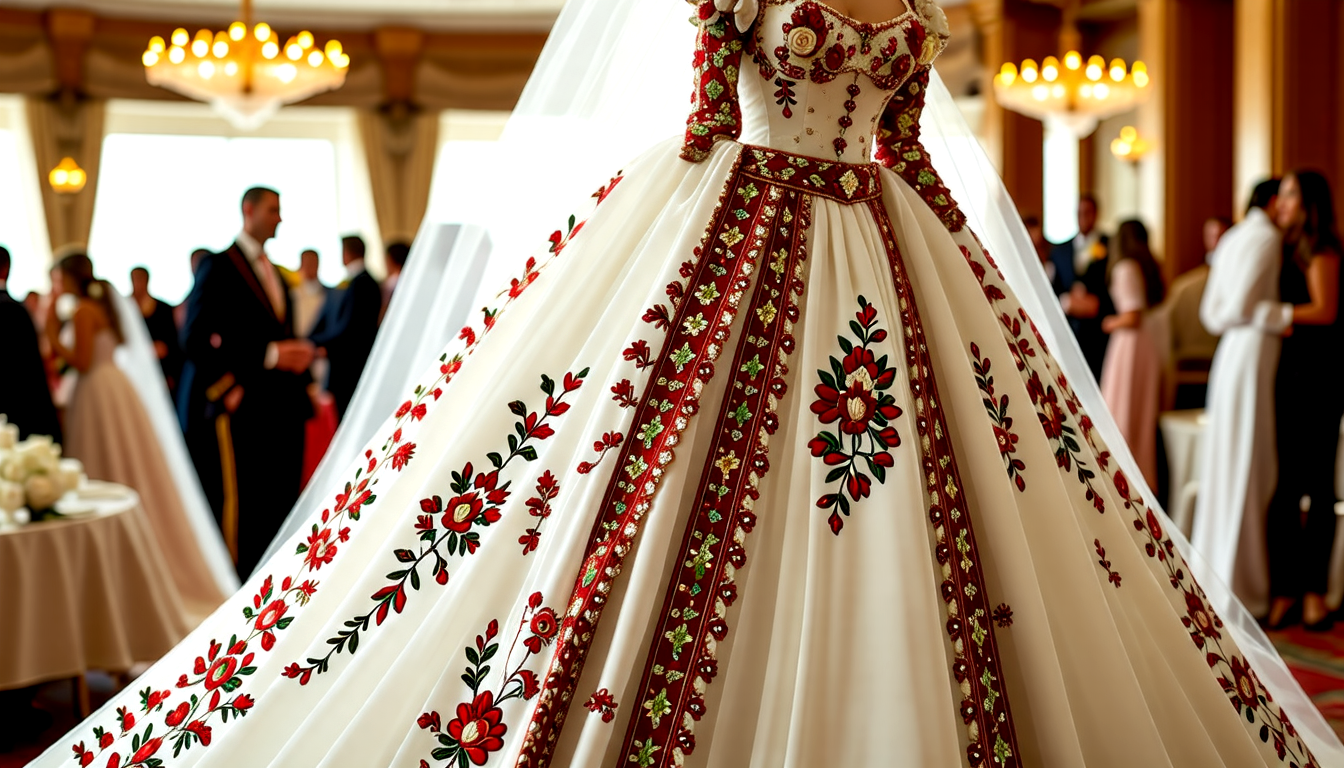
7 Key Features that Set Romanian Wedding Dresses Apart
Romanian wedding dresses are more than just garments; they are a celebration of rich traditions and intricate details. Each dress tells a story, blending historical influences with modern aesthetics. One feature that stands out is the use of vibrant embroidery, often done by hand, which reflects the local culture and folklore. These embroideries aren’t just decorative; they carry symbols and motifs that have been passed down through generations.
Another distinguishing element is the fabric choice. Traditional dresses frequently use materials like linen and cotton, providing both comfort and a timeless look. The bride’s attire often includes intricate lacework, adding a touch of elegance and sophistication.
One can’t overlook the colorful beadwork that adorns many wedding dresses. These beads are meticulously arranged to create patterns that sparkle and catch the eye. Additionally, many dresses feature layers of flowing skirts, allowing the bride to move gracefully throughout the wedding reception and other festivities.
Headpieces are also a crucial aspect, often crafted with flowers or intricate metalwork that complements the dress. These headpieces symbolize purity and Romanian culture saintly attributes.
The accessories, such as belts and sashes, are frequently adorned with traditional motifs, further enhancing the cultural significance. For a deeper dive into the traditions surrounding these weddings, I’ve detailed the entire process in my guide on how to get married in Romania.
Key Features:
- Hand-embroidered patterns
- Linen and cotton fabrics
- Intricate lacework
- Colorful beadwork
- Flowing, layered skirts
- Traditional headpieces
- Motif-adorned accessories
These features make this wedding dresses not just attire but a profound expression of heritage and artistry.
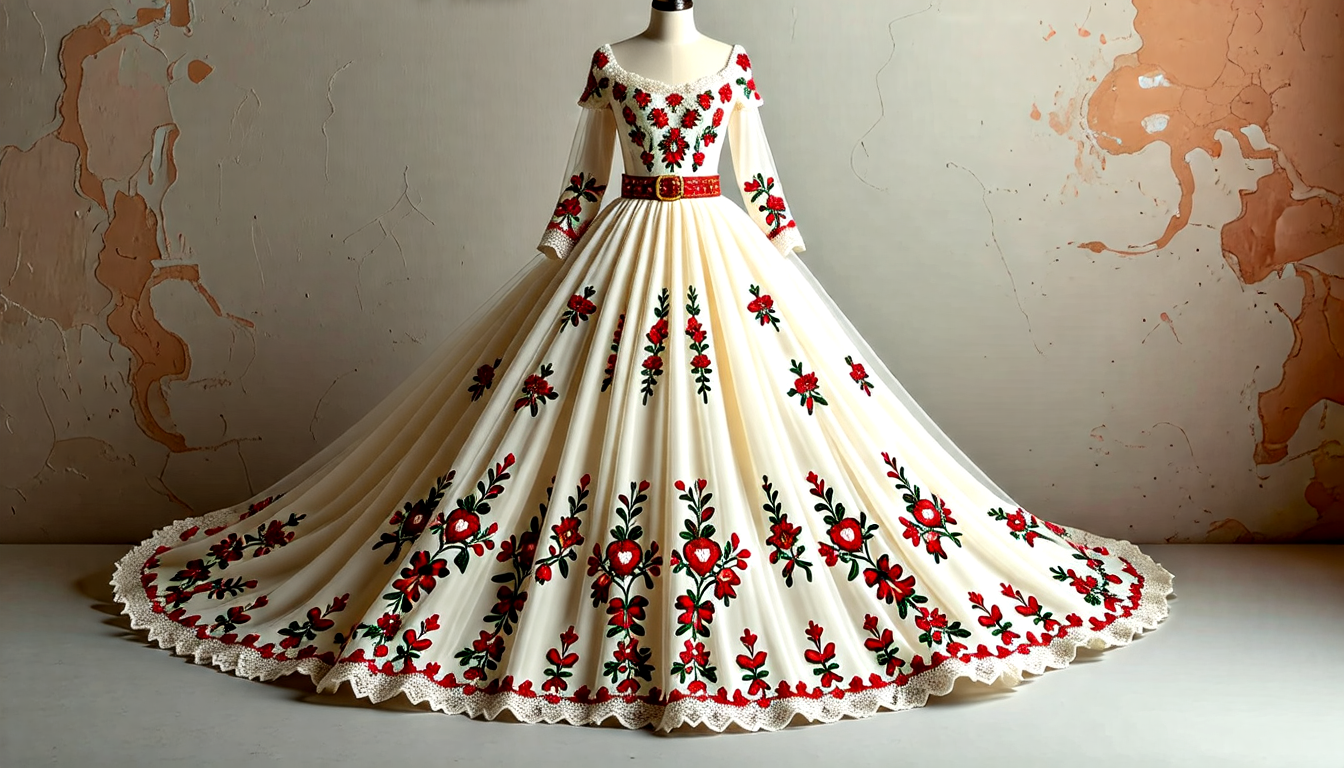
Within Romanian culture, the bride’s dress is more than just a garment; it is a tapestry of history and symbolism. Often hand-embroidered with intricate designs, these dresses capture the essence of Romanian tradition. The flowing fabric, adorned with colorful motifs, mirrors the vibrant spirit of the wedding celebration.
Typically crafted from linen, the dress is both elegant and comfortable, allowing the bride to move gracefully throughout the day. The groom’s attire often complements the bride’s, creating a harmonious visual display that ties the entire ceremony together. The wedding reception becomes a spectacle of traditional attire, where every piece tells a story.
During the ceremony, the bride’s dress plays a pivotal role. It is not just about aesthetics; it signifies purity, joy, and the blessings of the community. Family members, especially the parents, often have a say in the choice of the dress, adding layers of emotional and cultural significance.
In my travels through Bucharest, I’ve observed how these traditions are meticulously preserved and celebrated. The city’s rich cultural tapestry is evident not only in its architecture but also in its customs, such as the wedding cake that often features traditional Romanian designs. For more insights on what to explore in Bucharest, you can refer to my comprehensive travel guide.
In essence, the bride’s dress is a symbol of Romanian heritage, blending tradition with personal expression, making each wedding a unique and memorable event.
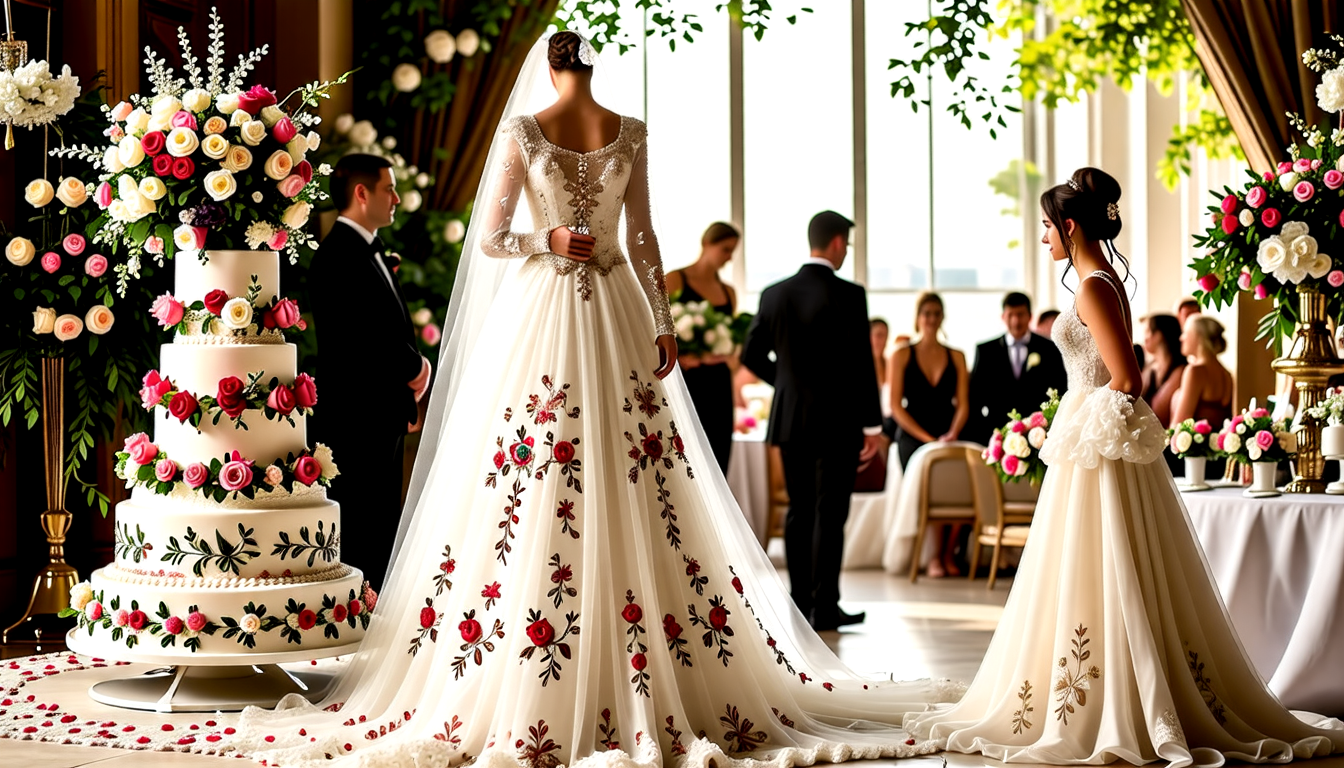
The Interplay of Groom, Bride, and Wedding Dress in Romanian Rituals
In wedding rituals, the interplay between bride, groom, and the wedding dress forms a vibrant tapestry of cultural richness. The bride often dons a wedding dress that is a masterpiece of craftsmanship. These dresses are typically made from high-quality fabrics, adorned with intricate embroidery symbolizing fertility and prosperity.
The dress not only highlights the beauty of the bride, but also reflects the rich heritage of Romanian traditions. The groom, dressed in traditional attire, complements the bride, creating a harmonious visual feast. The parents, too, play significant roles, dressing in their finest to honor this special day.
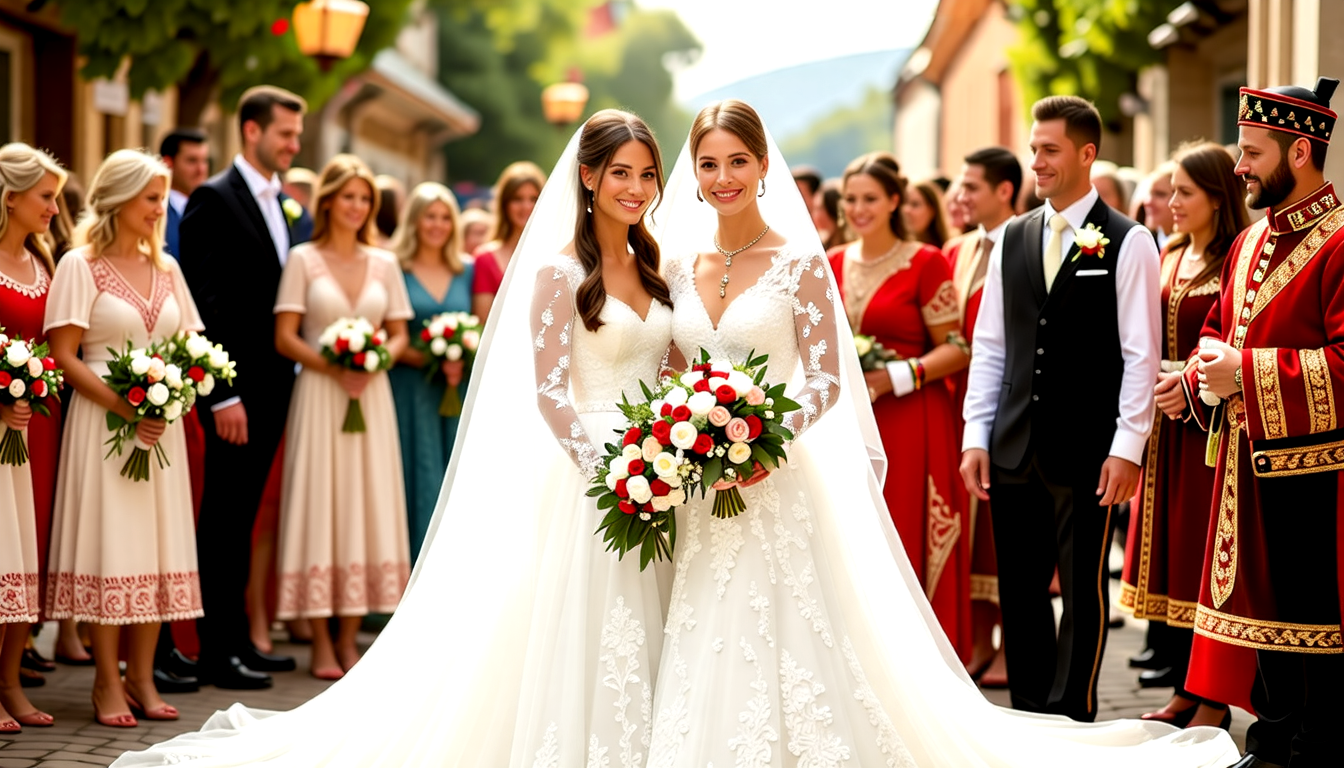
During the wedding reception, the bride’s gown often becomes a focal point in the wedding party. Guests marvel at the meticulous details while enjoying traditional music and dance. The joy and energy of the event are palpable, making it a memorable experience for everyone involved.
A key moment in Romanian rituals is when the bride and groom share their first dance, symbolizing unity and love. The wedding cake cutting ceremony follows, often featuring multiple layers and elaborate decorations, adding sweetness to the celebration.
The evening culminates in a lively wedding party, where friends and family join in celebrating the couple’s new journey. The entire event is a beautiful blend of tradition and modernity, reflecting the essence of romanian tradition.
| Aspect | Bride’s Role | Groom’s Role | Symbolism |
|---|---|---|---|
| Wedding Attire | Hand-embroidered dress | Traditional suit | Cultural heritage |
| Wedding Reception | Center of attention | Partner in dance | Unity and love |
| Wedding Cake | Participates in cutting ceremony | Participates in cutting ceremony | Sweetness and prosperity |
| Parents’ Involvement | Dresses in traditional clothing | Dresses in traditional clothing | Honor and respect |
| Wedding Party | Participates in traditional dances | Participates in traditional dances | Celebration of new beginnings |
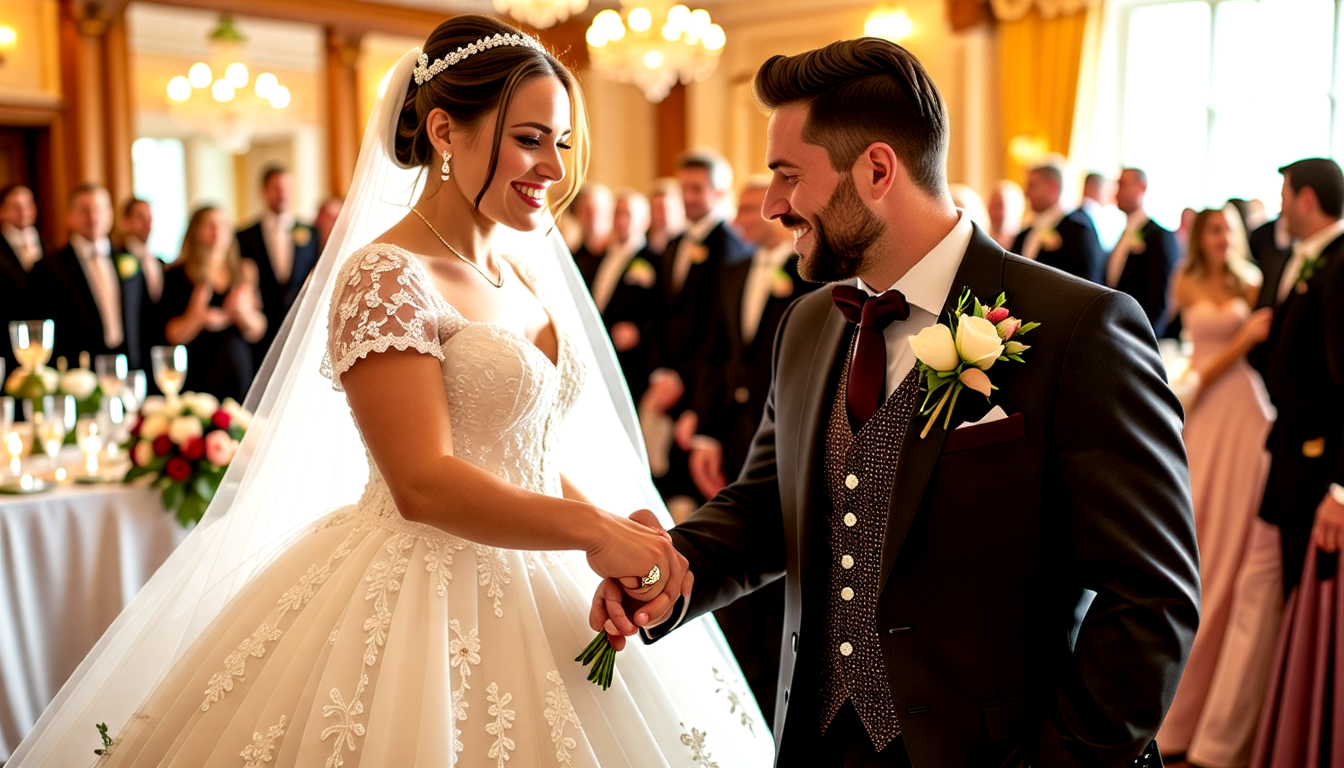
Traditional Romanian Groom Attire
The traditional Romanian groom attire varies significantly across different regions, each with its own unique historical and cultural significance. For instance, in the rural areas of Transylvania, the groom often wears a white shirt with intricate embroidery, paired with dark trousers and a wide belt. This belt is not just a fashion accessory but a symbol of strength and protection.
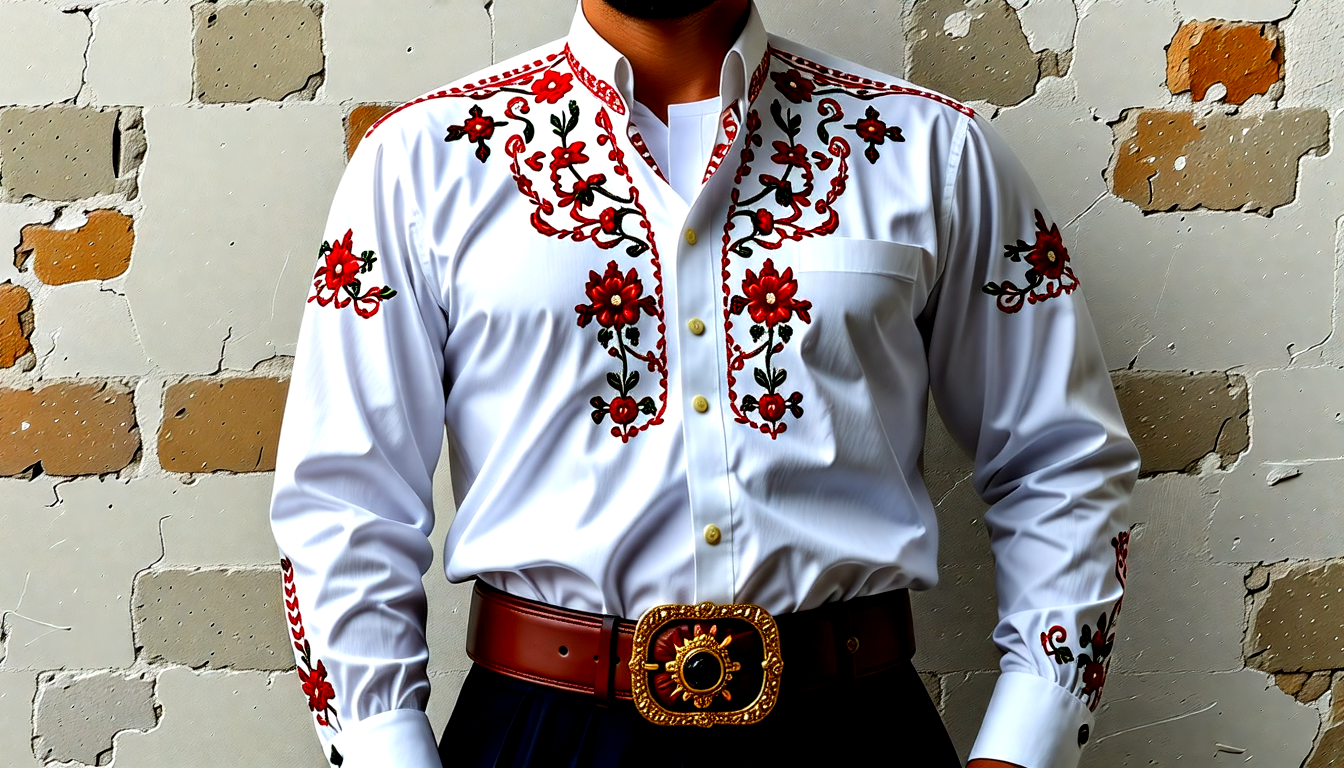
In contrast, grooms from the Maramureș region might don a long, woolen coat called a “suman,” which is richly decorated with colorful patterns. Regardless of the region, traditional Romanian groom attire is imbued with symbolic meanings, reflecting the groom’s readiness to embrace his new roles and responsibilities. These traditional elements are not just relics of the past but are sometimes adapted into modern groom attire, blending old with new to create a unique wedding ensemble.
The Groom’s Preparation and Role in Wedding Traditions
The preparation rituals and customs for the Romanian groom involve a series of time-honored practices that emphasize community and family involvement. On the morning of the wedding, it is customary for the groom to be dressed by his male relatives and friends, a ritual that symbolizes the support and guidance he will receive throughout his married life.
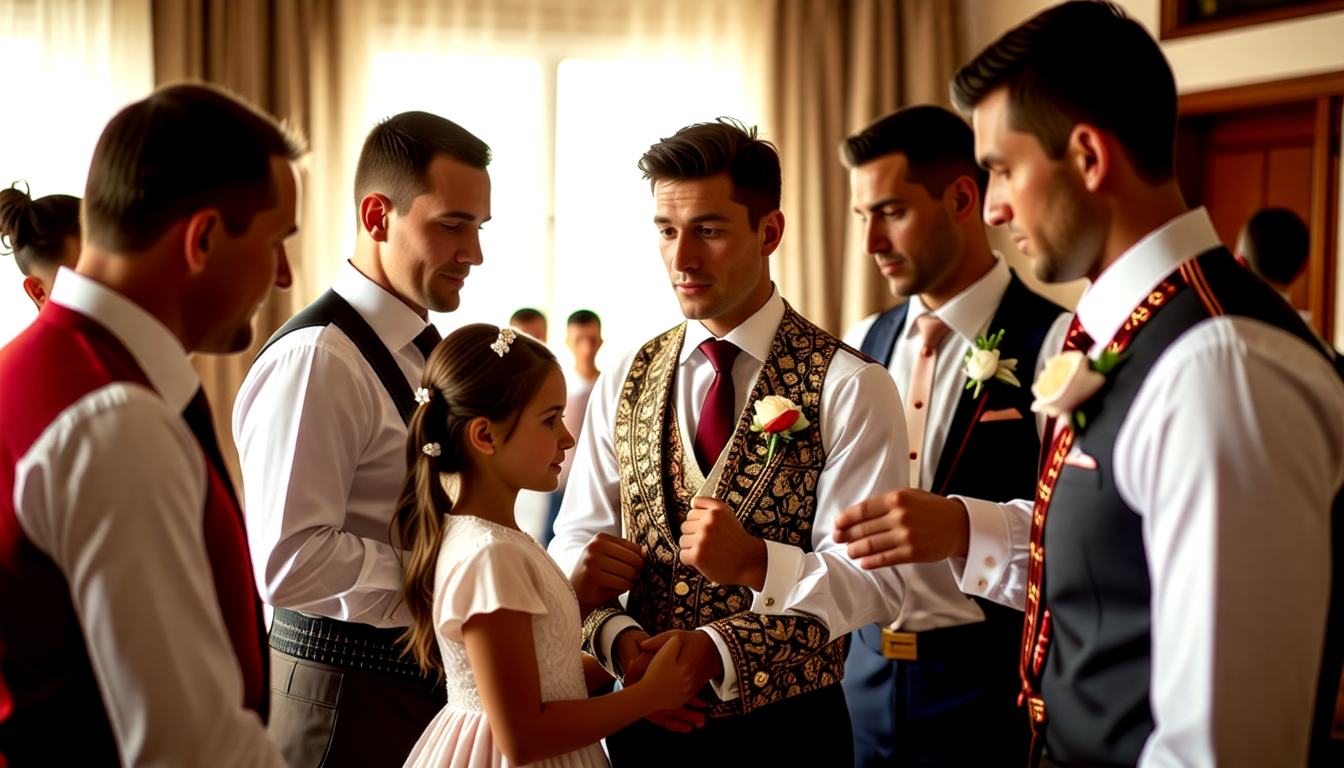
This event is often accompanied by traditional songs and blessings, creating a festive atmosphere. Additionally, the groom’s attire is carefully inspected to ensure every detail is perfect, reflecting the family’s pride and attention to tradition.
The groom also plays a crucial role in various wedding traditions and in the romanian wedding customs, such as leading the wedding procession and participating in symbolic acts like breaking bread or sharing a communal drink. These customs highlight the groom’s importance in the ceremony and his readiness to take on marital responsibilities, supported by the collective strength of his community and family.
